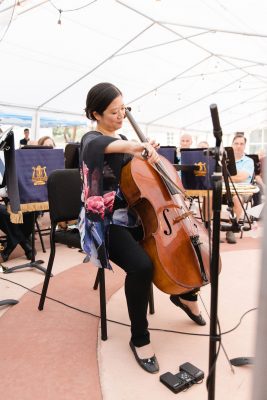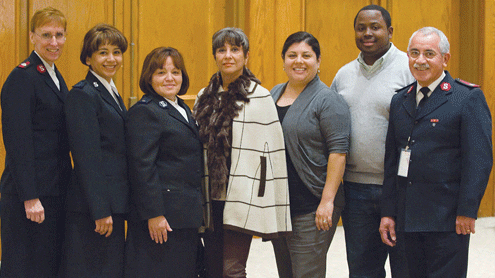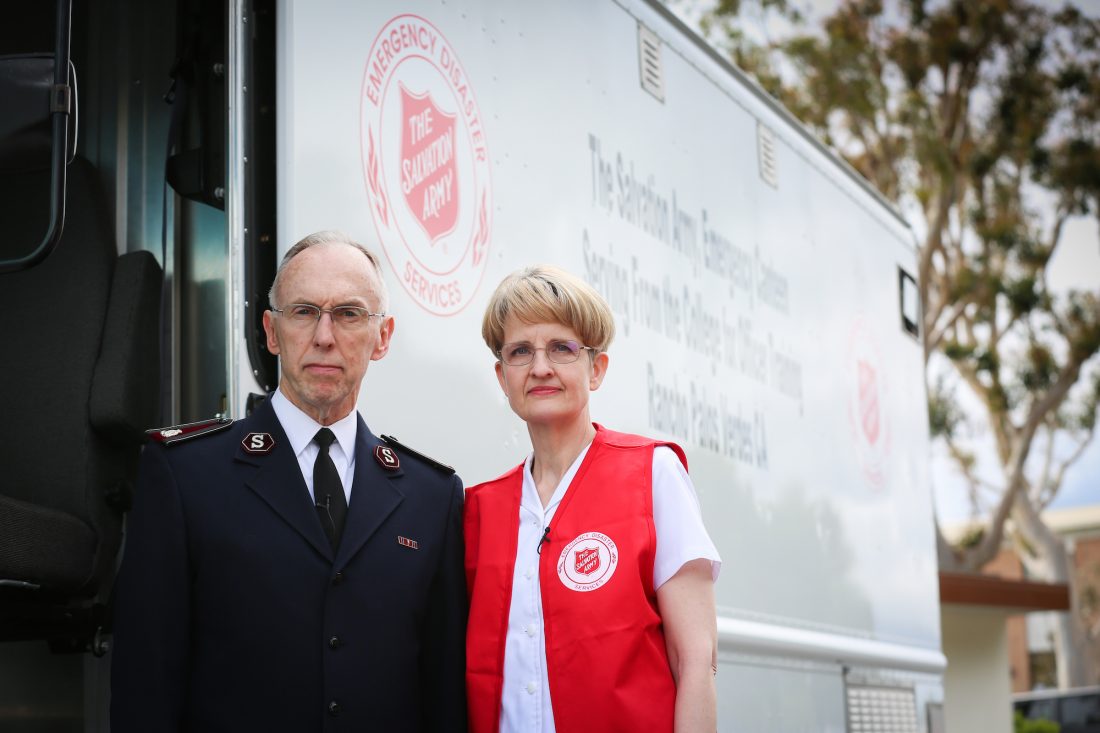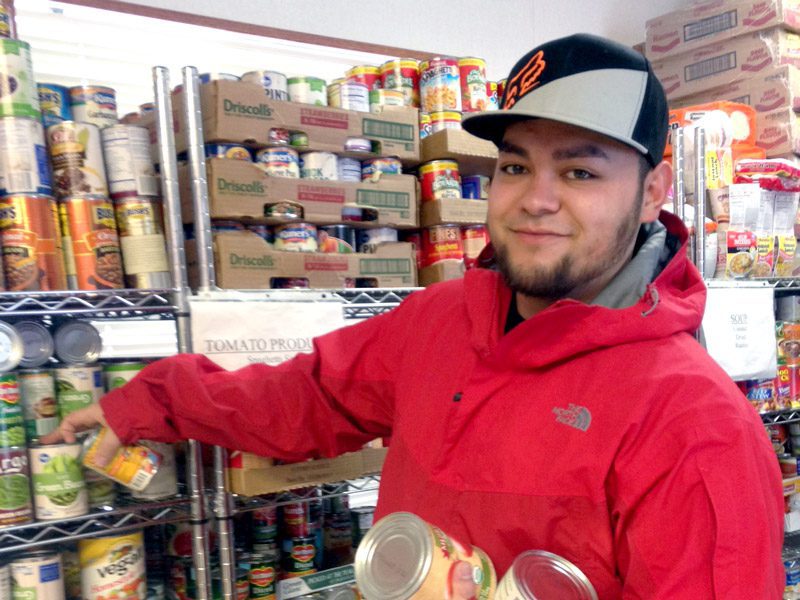Listen to this article
Listen to this article
Loading
Play
Pause
Options
0:00
-:--
1x
Playback Speed- 0.5
- 0.6
- 0.7
- 0.8
- 0.9
- 1
- 1.1
- 1.2
- 1.3
- 1.5
- 2
Audio Language
- English
- French
- German
- Italian
- Spanish
Open text
salvation army officers consider how to be the church during a pandemic. across the west, salvation army corps have resumed in-person meetings, with the last corps reopening their physical doors in summer 2021. for some locations, things are almost pre-pandemic normal, covid-19 guidelines notwithstanding. a pew research study from august 2020 found most u.s. adults expected to return to attending religious services in person as often as they did before the coronavirus outbreak. but as the pandemic continues, some worshippers who expected to return may still be seeking online worship opportunities—an option so popular that facebook created a prayer requests feature in response. the question remains: what’s next for the church? “god doesn’t want us to be afraid when we worship,” territorial program secretary lt. colonel lisa smith said. maybe god is prompting his people to try something different, not just scramble to return to pre-pandemic programming, she suggested. “covid gave many an opportunity to rest, which is a spiritual thing,” smith said. “i think god was calling us to figure out that rhythm of resting and being with him, before we’re frantically doing for him.”. for such a time as this. what god calls believers to do hasn’t changed, smith said. the two sides of the salvation army mission are the great commandment—to love god and to love our neighbor—and the great commission—to make disciples. covid hasn’t changed this, but perhaps now the mission requires different methods. the salvation army expanded its reach during the pandemic, assisting people who had never needed help before. courtesy karen gleason. “we found out that we were having an impact not just on their physical needs, but even spiritually,” smith said. “and that was an exciting development.”. the challenge is to grow that connection, deepen relationships and make disciples. “how do we manage to tell the world about jesus when people aren’t coming in our doors on a sunday morning?” smith asked. “let’s deal with who does. let’s encourage them so they can go out and be the church and be the soldiers of god in the community. let’s be the church, not just do church…this is the moment for innovation and creativity.”. what do people need now? before world war i, the salvation army wasn’t known for doughnut distribution. at the time, some creative thinkers asked, “what do these men on the front lines need?” the answer was they needed a taste of home. that’s what the doughnuts provided. “i want to encourage the creative approach to a new way to do church,” smith said. in communities where people are afraid to go out, church leaders—and salvation army soldiers—can seek other ways to reach people. “we have to find out what people are comfortable with,” smith said, adding that we may also need to measure church health differently. maybe the measure of our missional success is no longer how many seats are filled on a sunday morning. she suggested that for those corps where the weather is usually good, why not hold more outside services? why not do it every week? the neighborhood will notice. del oro divisional secretary for program major robin bottjen said northern california corps offered worship alternatives including drive-in church with radio transmission, outside services and live-streamed online services. in the bay area, corps officers are “listening to their people, trying their best to follow local guidelines and reconnecting with their people in any way they can,” said major dianne madsen, golden state divisional secretary for program. some corps members are ready to return to pre-pandemic programming and others are petrified, she said. “[corps officers] have a huge job of navigating each side of the equation with compassion and grace. within a congregation, an officer can face a wide spectrum of perspectives, plus dealing with their own feelings and opinions.”. major vickie harvey, northwest divisional secretary for program, noted the impact of locational differences in making a way forward. “serving very different populations in very different communities means a one-size-fits-all response is not really possible,” she said. southern california divisional program secretary captain ashley koebel said minority groups hit hardest by the virus have correspondingly greater fears. “san gabriel, [which] was the first corps to bring concerns of the pandemic to us at the divisional level, still has a lot of fear in its soldiers for return,” koebel said. “the los angeles metro corps are still trickling back in, but taking considerable steps for safety.”. she highlighted the tustin ranch corps’ success online and in-person, and the riverside corps’ demographically relevant online content, saying, “the online services looked more like a talk show—really well done and good engagement.”. for corps taking the steps to reopen for in-person services, small groups can be a way to start. koebel said the santa monica corps began this way; now it holds outdoor services in its courtyard. la central changed the sanctuary backdrop to enhance its online look and continues to offer services online and in-person, and la korean corps successfully switched to two services to handle social distancing. “there has been a slew of creative and ‘outside the box’ responses to the pandemic,” koebel said. “i think the greatest has simply been those who have been flexible and kept the main goal of preaching jesus to the lost and growing people in faith.”. finding a balance. being the church in 2021 involves creativity and a balance between staying connected with established congregants and welcoming new ones. when captains harryette and sean o’brien transferred to the torrance (california) corps in the middle of the shutdown, they didn’t have the advantage of already knowing their congregation. “we called everyone in the corps roll—everyone,” sean o’brien said. “we did this each month for probably more than six months before we met for in-person worship. harryette sent out cards as well. we wanted people to know we are still here and praying for them.”. when the corps re-opened this summer, they kept the service simple: welcome, praise and worship, testimony and sermon—no sunday school or any other activities. “the testimony is meant as a chance for people to hear from each other and share what they’ve been doing during the pandemic and how god has been working in their lives, kind of like a reintroduction to each other, ” said o’brien. worship service attendance, now growing, initially averaged a little over 50 percent of pre-pandemic numbers. the corps held an open house for the community in september. courtesy joy lim. the tustin ranch corps grew during the pandemic, finding the balance between bringing back established members and welcoming new ones. it held a series of outdoor summer concerts, welcoming newcomers from the community. the corps also maintains an up-to-date facebook page, posting its sunday services and highlighting its activities. “the key is we remained in constant contact with our people,” corps officer captain nesan kistan said. “we adapted, moving to outdoor services and finding creative responses to keep our church family and community connected. during covid we grew and attracted numerous families, and over the last couple of months our summer concerts were part of our strategy to engage our community.”. for the church, finding that crucial balance boils down to loving people and hard work. “god will bless that,” concord (california) corps officer major gwyn jones said. “if you put the effort in, then god will honor the effort.”. do good:. more than red kettles and thrift stores—discover how the salvation army impacts people’s lives. what’s your story? how might it impact others? here’s where to start your personal journey. discover how the salvation army took its ministry online during the pandemic.
Open context player
Close context player
Plays:-Audio plays count
salvation army officers consider how to be the church during a pandemic. across the west, salvation army corps have resumed in-person meetings, with the last corps reopening their physical doors in summer 2021. for some locations, things are almost pre-pandemic normal, covid-19 guidelines notwithstanding. a pew research study from august 2020 found most u.s. adults expected to return to attending religious services in person as often as they did before the coronavirus outbreak. but as the pandemic continues, some worshippers who expected to return may still be seeking online worship opportunities—an option so popular that facebook created a prayer requests feature in response. the question remains: what’s next for the church? “god doesn’t want us to be afraid when we worship,” territorial program secretary lt. colonel lisa smith said. maybe god is prompting his people to try something different, not just scramble to return to pre-pandemic programming, she suggested. “covid gave many an opportunity to rest, which is a spiritual thing,” smith said. “i think god was calling us to figure out that rhythm of resting and being with him, before we’re frantically doing for him.”. for such a time as this. what god calls believers to do hasn’t changed, smith said. the two sides of the salvation army mission are the great commandment—to love god and to love our neighbor—and the great commission—to make disciples. covid hasn’t changed this, but perhaps now the mission requires different methods. the salvation army expanded its reach during the pandemic, assisting people who had never needed help before. courtesy karen gleason. “we found out that we were having an impact not just on their physical needs, but even spiritually,” smith said. “and that was an exciting development.”. the challenge is to grow that connection, deepen relationships and make disciples. “how do we manage to tell the world about jesus when people aren’t coming in our doors on a sunday morning?” smith asked. “let’s deal with who does. let’s encourage them so they can go out and be the church and be the soldiers of god in the community. let’s be the church, not just do church…this is the moment for innovation and creativity.”. what do people need now? before world war i, the salvation army wasn’t known for doughnut distribution. at the time, some creative thinkers asked, “what do these men on the front lines need?” the answer was they needed a taste of home. that’s what the doughnuts provided. “i want to encourage the creative approach to a new way to do church,” smith said. in communities where people are afraid to go out, church leaders—and salvation army soldiers—can seek other ways to reach people. “we have to find out what people are comfortable with,” smith said, adding that we may also need to measure church health differently. maybe the measure of our missional success is no longer how many seats are filled on a sunday morning. she suggested that for those corps where the weather is usually good, why not hold more outside services? why not do it every week? the neighborhood will notice. del oro divisional secretary for program major robin bottjen said northern california corps offered worship alternatives including drive-in church with radio transmission, outside services and live-streamed online services. in the bay area, corps officers are “listening to their people, trying their best to follow local guidelines and reconnecting with their people in any way they can,” said major dianne madsen, golden state divisional secretary for program. some corps members are ready to return to pre-pandemic programming and others are petrified, she said. “[corps officers] have a huge job of navigating each side of the equation with compassion and grace. within a congregation, an officer can face a wide spectrum of perspectives, plus dealing with their own feelings and opinions.”. major vickie harvey, northwest divisional secretary for program, noted the impact of locational differences in making a way forward. “serving very different populations in very different communities means a one-size-fits-all response is not really possible,” she said. southern california divisional program secretary captain ashley koebel said minority groups hit hardest by the virus have correspondingly greater fears. “san gabriel, [which] was the first corps to bring concerns of the pandemic to us at the divisional level, still has a lot of fear in its soldiers for return,” koebel said. “the los angeles metro corps are still trickling back in, but taking considerable steps for safety.”. she highlighted the tustin ranch corps’ success online and in-person, and the riverside corps’ demographically relevant online content, saying, “the online services looked more like a talk show—really well done and good engagement.”. for corps taking the steps to reopen for in-person services, small groups can be a way to start. koebel said the santa monica corps began this way; now it holds outdoor services in its courtyard. la central changed the sanctuary backdrop to enhance its online look and continues to offer services online and in-person, and la korean corps successfully switched to two services to handle social distancing. “there has been a slew of creative and ‘outside the box’ responses to the pandemic,” koebel said. “i think the greatest has simply been those who have been flexible and kept the main goal of preaching jesus to the lost and growing people in faith.”. finding a balance. being the church in 2021 involves creativity and a balance between staying connected with established congregants and welcoming new ones. when captains harryette and sean o’brien transferred to the torrance (california) corps in the middle of the shutdown, they didn’t have the advantage of already knowing their congregation. “we called everyone in the corps roll—everyone,” sean o’brien said. “we did this each month for probably more than six months before we met for in-person worship. harryette sent out cards as well. we wanted people to know we are still here and praying for them.”. when the corps re-opened this summer, they kept the service simple: welcome, praise and worship, testimony and sermon—no sunday school or any other activities. “the testimony is meant as a chance for people to hear from each other and share what they’ve been doing during the pandemic and how god has been working in their lives, kind of like a reintroduction to each other, ” said o’brien. worship service attendance, now growing, initially averaged a little over 50 percent of pre-pandemic numbers. the corps held an open house for the community in september. courtesy joy lim. the tustin ranch corps grew during the pandemic, finding the balance between bringing back established members and welcoming new ones. it held a series of outdoor summer concerts, welcoming newcomers from the community. the corps also maintains an up-to-date facebook page, posting its sunday services and highlighting its activities. “the key is we remained in constant contact with our people,” corps officer captain nesan kistan said. “we adapted, moving to outdoor services and finding creative responses to keep our church family and community connected. during covid we grew and attracted numerous families, and over the last couple of months our summer concerts were part of our strategy to engage our community.”. for the church, finding that crucial balance boils down to loving people and hard work. “god will bless that,” concord (california) corps officer major gwyn jones said. “if you put the effort in, then god will honor the effort.”. do good:. more than red kettles and thrift stores—discover how the salvation army impacts people’s lives. what’s your story? how might it impact others? here’s where to start your personal journey. discover how the salvation army took its ministry online during the pandemic.
Listen to this article


















